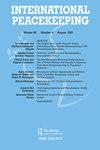The Southern African Development Community’s Mission in Mozambique (SAMIM): Policymaking and Effectiveness
IF 1.3
2区 社会学
Q2 INTERNATIONAL RELATIONS
引用次数: 1
Abstract
ABSTRACT On 23 June 2021, after months of deliberations, the Southern African Development Community (SADC) approved the establishment of the SADC Mission in Mozambique (SAMIM) in response to escalating violent extremism and insurgency by an Islamist armed group, Al-Shabaab or Al-Sunnah wa Jama’ah (ASWJ), in Mozambique’s northern Cabo Delgado province, which posed the risk of regional contagion. SAMIM was deployed under scenario 6 of the African Standby Force (ASF) with a mandate focused on supporting the Mozambican government to combat terrorism and violent extremism in Cabo Delgado. Its mandate also centred on strengthening and maintaining peace and security; restoring law and order; and assisting the government and humanitarian agencies to provide humanitarian relief to the affected population. This paper contributes to raising public understanding of the regional and continental policies and principles underpinning the SADC decision-making process regarding the deployment of peace missions and the effectiveness of SAMIM in fulfilling its mandated tasks until its first anniversary. It identified the relative pacification of Cabo Delgado as a crucial strategic and operational impact of SAMIM’s exceptional military intervention, which facilitated its segue into a multidimensional peacebuilding mission. Six principal constraints-cum-opportunities of SAMIM, which had a significant bearing on its effectiveness, are discussed.南部非洲发展共同体在莫桑比克的使命:决策与有效性
摘要2021年6月23日,经过数月的审议,南部非洲发展共同体(SADC)批准成立南部非洲共同体驻莫桑比克特派团(SAMIM),以应对伊斯兰武装组织青年党(ASWJ)在莫桑比克北部德尔加杜角省不断升级的暴力极端主义和叛乱,这带来了区域传染的风险。SAMIM是根据非洲待命部队(ASF)的设想6部署的,其任务重点是支持莫桑比克政府打击德尔加杜角的恐怖主义和暴力极端主义。其任务还集中于加强和维护和平与安全;恢复法律和秩序;协助政府和人道主义机构向受灾群众提供人道主义救济。本文件有助于提高公众对南共体关于部署和平特派团的决策过程所依据的区域和大陆政策和原则的理解,以及南共体特派团在一周年之前履行其授权任务的有效性。它认为,德尔加杜角的相对平静是SAMIM特殊军事干预的一个关键战略和行动影响,这有助于其转变为一个多层面的建设和平任务。讨论了SAMIM的六个主要制约因素和机遇,它们对其有效性有着重要影响。
本文章由计算机程序翻译,如有差异,请以英文原文为准。
求助全文
约1分钟内获得全文
求助全文

 求助内容:
求助内容: 应助结果提醒方式:
应助结果提醒方式:


